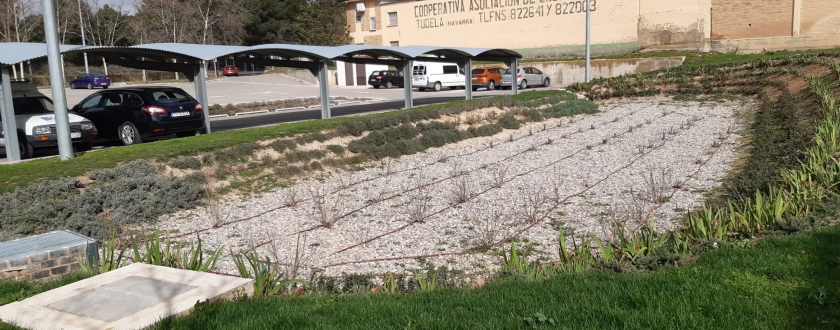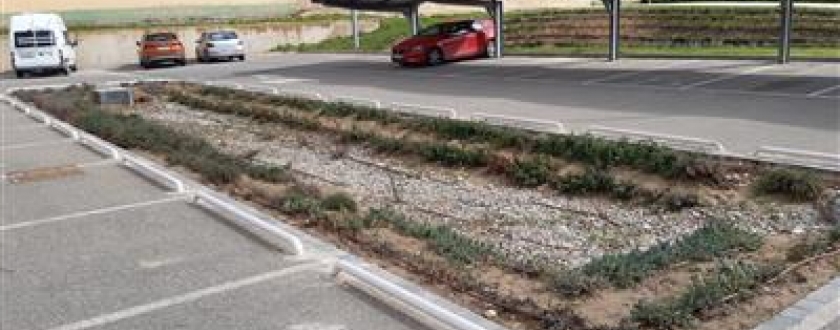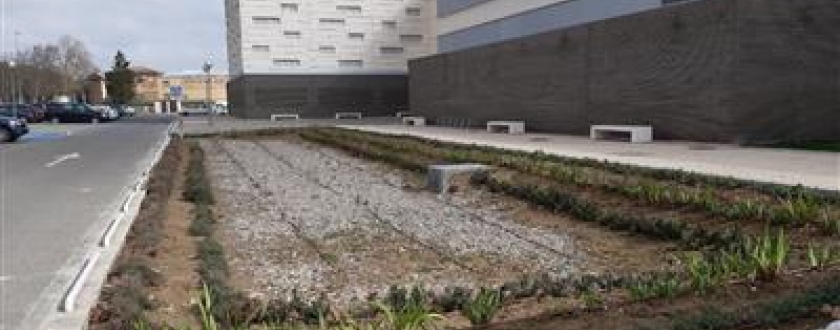Sustainable Urban Drainage System (SUDS) prototype - Action C2.3 LIFE NAdapta
Description of the case study
Building, road, and parking lot construction has made a large part of the ground impermeable and, as a result, rain water that would filter through the soil before now moves as surface run-off instead of seepage. This alteration to the natural water cycle increases the risk of floods, and causes rapid concentrations of rain water, producing flooding and bottlenecks that can overrun sewer systems. In addition to the problem of large amounts of run-off, suspended contaminants that the rain washes off the surfaces of buildings, traffic (such as fuel, heavy metals, etc.), and those suspended in the air are carried along.
In drainage systems with unitary networks where sewage from homes and rain water mix, large flows make wastewater treatment stations unable to treat all the water coming in during certain rain events, and must release effluents directly into the river without purification.
LIFE NAdapta will improve adaptive water management in the Chartered Community of Navarre. Among these actions, a prototype Sustainable Urban Drainage System (SUDS) has been built within the C2.3 “Adaptation of urban sewer systems through the implementation of SUDS”.
The implementation of this pilot project will demonstrate its advantages and viability for the management of urban run-off water, reducing the contamination load, allowing run-off water filtration through the substrate, and protecting the sewage system. In addition, the economic costs of rainwater management are minimised, improving the urban landscape and biodiversity.
» Studying the benefits of SUDS, both in terms of volumes of run-off water managed in situ, as well as the reduction of contaminants present therein.
» Diverting water during periods of intense rain.
» Reducing the flows to be treated in the treatment plant, with subsequent energy savings.
» Reducing the probability of releases.
» Encouraging rain seepage.
» Establishing a relationship between easily determined physical-chemical parameters (suspended solids) and the concentration of heavy metals in run-off water.
» Establishing the relationship between precipitation and volumes of run-off water produced, as well as releases and their quality.
The project is currently in the monitoring and study phase. Different level, flow, and rain measurement equipment has been installed. Currently, run-off and soil samples have been taken before and after the installation of the prototype to estimate the qualitative and quantitative improvements.
As such, expectations are:
» A reduction in releases, as well as a reduction of the presence of contaminants therein (plastic bags, packaging, cigarette butts, etc.).
» Rationing out the run-off produced, increasing the time it takes the network to be overrun by excess flows (for example, with heavy rains).
Specifically, the project has allowed for 3,983 m2 to be drained and 2,293 m2 to be distributed in two areas. In addition, a reduction in flows to be treated by the treatment plant is expected, with its subsequent energy savings, water routing, and reduced risk of floods.
Case study developed, implemented, and partly funded as a climate change adaptation measure.
NILSA and the Public University of Navarre (UPNA)
Additional Information
NILSA and the Public University of Navarre (UPNA).
Success factors:
To date, the campus had been separating wastewater and rain water collectors that ultimately flowed together to a single unitary collector, meaning that both the rain water and wastewater from homes mixed together and ended up in the treatment plant. As such, this situation meant that a large amount of rain water ended up being treated unnecessarily, since it could have been filtered through the ground in perfect conditions. The optimal solution becomes building separating drainage systems that distinguish between wastewater (and direct it towards the treatment plant) and rainwater (which does not need to be treated). However, if the rainwater filters through the ground where it lands, specifically through SUDS like those in Tudela, this second aspect is not necessary.
The cost was 79,104 euros (VAT excluded), which was 40% financed by the water treatment levy that NILSA manages and all taxpayers pay through their water bill, and 60% financed by the European Union’s LIFE NADAPTA programme.
This action falls within the framework of the European LIFE NADAPTA project.
04/01/2018 - 12/31/2025 (7 years - in progress)
Reference information
PYRENEAN CLIMATE CHANGE OBSERVATORY
Avenida Nuestra Señora de la Victoria, 8
22.700 - Jaca
Huesca - España
+34 974 36 31 00
info_opcc@ctp.org







